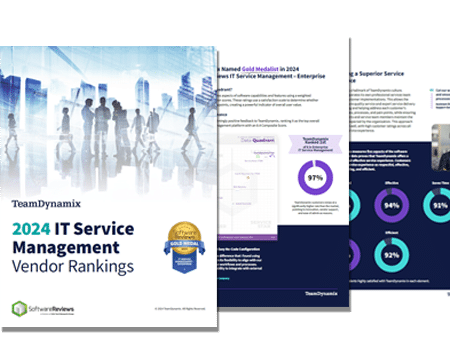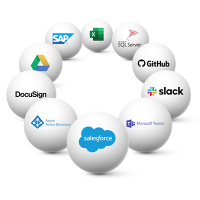
Understanding Change Management and Its Importance Within Your Organization
Did you know that a significant number of IT incidents occur when someone makes a change to one system that then affects other systems in

The Info-Tech ranking report offers a unique view of the market based entirely on in-depth customer interviews. Download the Info-Tech ITSM Quadrant and Customer Viewpoint report today.

We’ll show you some of our best situations and show you exactly how to execute them to get immediate results. The best part is, iPaaS tools often feature easy-to-use click and drag functionality, meaning you don’t need a dedicated employee building integrations and workflows.

System Integrators, Value Added Resellers, Technology Providers, and Buying Consortiums can benefit from a partnership with TeamDynamix.

The Info-Tech ranking report offers a unique view of the market based entirely on in-depth customer interviews. Download the Info-Tech ITSM Quadrant and Customer Viewpoint report to gain a better understanding of key vendor strengths and emerging market requirements.
As IT leaders, you play a critical role in implementing new technologies that can streamline operations, improve customer experiences, and empower employees. However, successfully driving technology adoption can be challenging due to factors like resistance to change, lack of understanding and technical barriers.
In this comprehensive guide, we’ll explore tips and strategies for IT leaders to overcome these challenges and increase the adoption of new technologies as part of a successful digital transformation journey.
Before diving into the solutions, it’s essential to recognize the challenges that come with implementing new technologies as part of your organization’s digital transformation:
To overcome these challenges, it’s crucial to address the needs of different stakeholders and to properly communicate what is changing, why it’s changing and how the new processes or technology will improve things for everyone involved. In addition, you should invest in technology that is easy to use, easy to own and easy to operate. Many low-code/no-code tools are gaining popularity in IT because they are easier to manage, and you can empower technical employees outside of IT to use the tools.
So, let’s take a look at some of the things you should consider for each stakeholder:
For Employees
For Customers
Consider implementing these tactics to help drive user adoption and engagement for new technology – whether that’s a new IT Service Management platform, a conversational AI chatbot or a new project management system:
To assess the success of your technology adoption efforts, consider the following:
Finally, it’s essential to adopt a mindset of continuous improvement:
By understanding the challenges, addressing stakeholder needs, implementing practical tactics and continuously measuring and improving the adoption process, IT leaders can successfully drive the adoption of new technologies and ensure a smooth digital transformation. Embrace the journey, and watch your organization thrive in the digital age.

Did you know that a significant number of IT incidents occur when someone makes a change to one system that then affects other systems in

The construction industry can be very volatile, with a high employee turnover rate due to seasonal fluctuations in the workforce. A key challenge for the

A study from Information Week and TeamDynamix shows companies are looking to invest in IT Service Management (ITSM) software that is simple to administer and
TeamDynamix’s award-winning SaaS cloud solution offers IT Service and Project Management together on one platform with enterprise integration and automation.
[email protected]
(877) 752-6196
Contact Us
